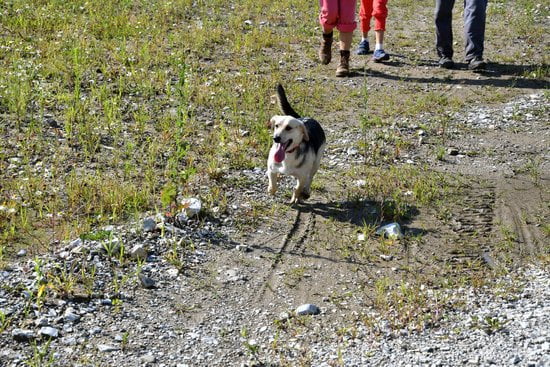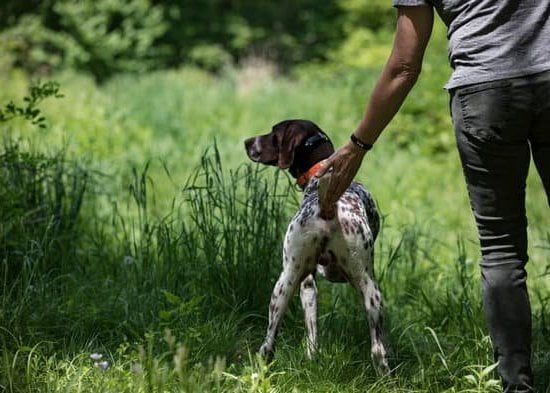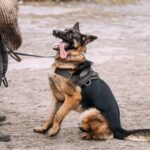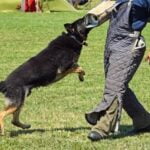Police dog training is an essential aspect of law enforcement, as these specially trained K9 units play a crucial role in various operations. From apprehending suspects to detecting narcotics and providing search and rescue support, police dogs are valuable assets in maintaining public safety. This article will delve into the world of police dog training, exploring its history, selection process, specialized training, the handler’s role, challenges, success stories, and the ongoing need for effective training.
The history of police dog training dates back to ancient times when dogs were used in warfare and hunting. Over the years, this practice has evolved into highly specialized training programs that cater to different law enforcement needs.
The selection process involved in choosing these exceptional canine officers is rigorous and requires specific qualities that make them well-suited for the job. Once selected, these dogs undergo training to master basic commands and are further trained for specialized tasks such as narcotics detection and search and rescue missions.
Police dog training also emphasizes the importance of building a strong bond between the K9 partner and their handler. This relationship is vital in ensuring effective communication and teamwork during operations. The challenges faced in police dog training are unique and demand continuous adaptation to meet evolving threats.
Despite the obstacles, there have been numerous success stories showcasing the invaluable contributions of police dogs in actual operations. These cases highlight the ongoing need for effective police dog training to meet the demands of modern law enforcement.
History of Police Dog Training
The history of police dog training dates back to ancient times, where dogs were used for various tasks such as hunting, herding, and protection. It is believed that the ancient Egyptians, Greeks, and Romans trained their dogs for military and guarding purposes. However, the modern concept of police dog training can be traced back to the 18th century in Europe, where bloodhounds were used to track down criminals.
Evolution of Police Dog Training
In the 19th century, more formalized police dog training programs began to emerge in Europe. The training focused on obedience, agility, tracking, and protection skills. As law enforcement agencies recognized the effectiveness of using dogs in police work, the first official K9 unit was established in Belgium in 1899. From there, police dog training techniques continued to evolve with a greater emphasis on specialized skills such as narcotics detection and search and rescue operations.
Modern Day Police Dog Training
Today, police dog training has become highly sophisticated and specialized. Law enforcement agencies use a variety of breeds such as German Shepherds, Belgian Malinois, Labrador Retrievers, and Dutch Shepherds for K9 units. The dogs undergo rigorous selection processes based on their temperament, drives, and physical abilities before undergoing extensive police dog training programs. These programs encompass basic obedience commands as well as specialized skills tailored to the specific needs of law enforcement agencies.
As technology continues to advance, so does police dog training methods. The use of positive reinforcement techniques combined with modern equipment has led to more effective and efficient training programs for police dogs. With the ongoing evolution of police dog training methods, law enforcement agencies can continue to rely on their K9 partners for various tasks that aid in maintaining public safety and security.
The Selection Process
Assessment and Evaluation
During the selection process, potential police dogs undergo assessments to evaluate their suitability for the job. This includes evaluating their temperament, drive, and willingness to work. Additionally, physical health checks are conducted to ensure that the dogs are in peak condition to handle the demands of law enforcement work. The evaluation process is thorough and aims to select only the best candidates for police dog training.
Specialized Training Programs
Once selected, police dogs go through specialized training programs that prepare them for their roles in law enforcement. These programs focus on obedience training, agility exercises, scent detection, and other necessary skills required for police work.
The handlers play a significant role during this phase as they build a strong bond with their K9 partners and guide them through the rigorous training process. Through consistent and dedicated training, police dogs develop into highly skilled and reliable assets in various law enforcement operations.
The Role of Positive Reinforcement
Effective police dog training relies on positive reinforcement techniques to motivate and encourage desired behaviors in the dogs. Rewards such as treats or toys are used to reinforce good behavior and obedience during training sessions. Positive reinforcement creates a strong bond between the handler and the K9 partner while also ensuring that the dogs enjoy their training experience. This approach enhances learning retention and overall performance of police dogs in real-life situations.
Basic Commands Taught in Police Dog Training
In police dog training, basic commands are the foundation for all other specialized tasks that a K9 unit may be required to perform. These essential commands not only enable effective communication between the handler and the dog but also ensure the safety and success of operations in the field. The following are some of the basic commands that are typically taught during police dog training:
- Sit: This command is crucial for maintaining control over the dog in various situations, such as during searches or when approaching a suspect.
- Stay: Teaching a police dog to stay in one place until given further instructions is vital for maintaining order and ensuring safety during operations.
- Heel: This command trains the dog to walk closely alongside the handler without pulling or straying off course, allowing for smooth and coordinated movement during patrols or searches.
- Come: A fundamental command that calls the dog back to the handler’s side, this is essential for recall in case of emergency or when it’s time to end an operation.
While these basic commands may seem simple, they form the basis for more advanced training and are crucial for creating a disciplined and reliable police dog. Consistent practice and reinforcement of these commands are essential to ensure that the K9 unit can perform at their best in high-pressure situations.
Continuing Education
In addition to these basic commands, ongoing training and education are necessary to maintain a police dog’s skills throughout their career. From regular refresher courses on obedience and discipline to continuous practice of specialized tasks such as tracking or apprehension techniques, police dogs undergo regular training sessions with their handlers to continually improve their performance.
The evolving nature of law enforcement requires that both dogs and handlers stay up-to-date with the latest tactics and technology, making continuing education an integral part of police dog training.
Overall, mastering these basic commands sets a solid foundation for ongoing success in police dog training. Through consistent practice, positive reinforcement, and ongoing education, K9 units can effectively carry out their duties in service to law enforcement agencies and communities.
Specialized Training for Police Dogs
- Narcotics Detection: Police dogs are trained to use their keen sense of smell to detect the presence of illegal narcotics. This type of training is essential in helping law enforcement agencies combat drug trafficking and keep communities safe.
- Search and Rescue: Police dogs are also trained to assist in search and rescue operations, particularly in finding missing persons or locating individuals trapped in disaster areas. They are taught to track scents over various terrains and environments, making them valuable assets in emergency situations.
- Explosives Detection: Some police dogs receive specialized training to detect explosives, aiding in the prevention of terrorist attacks and ensuring public safety at large events or high-risk locations.
- Cadaver Detection: In cases involving missing persons or crime scenes, police dogs trained in cadaver detection can assist in locating human remains, providing crucial evidence for investigations.
The specialized training of police dogs not only enhances their abilities but also significantly contributes to the overall effectiveness of law enforcement efforts. It is a vital aspect of police dog training that allows these K9 units to fulfill a variety of essential roles in maintaining public safety.
The Role of the Handler
Police dog training is not just about the dogs themselves, but also about the crucial role that handlers play in building a strong relationship with their K9 partners. The bond between a police dog and its handler is essential for effective teamwork and communication in high-pressure situations. Handlers are responsible for not only training their dogs, but also providing them with care, protection, and guidance throughout their careers.
One of the key aspects of the handler’s role in police dog training is understanding the individual needs and characteristics of their K9 partner. Each dog has its own personality, strengths, and weaknesses, and it is the handler’s responsibility to tailor their training methods accordingly. By recognizing and respecting the unique traits of each police dog, handlers can develop a stronger bond based on trust, respect, and mutual understanding.
In addition to training commands and techniques, handlers are also tasked with ensuring the overall well-being of their K9 partners. This includes providing proper nutrition, exercise, veterinary care, as well as mental stimulation to keep the dogs engaged and motivated. A healthy and happy police dog is more likely to perform at its best during operations, making the handler’s role even more crucial in maintaining the overall welfare of their K9 partner throughout their career in law enforcement.
Challenges and Obstacles in Police Dog Training
Police dog training is a rigorous and demanding process that comes with its own set of challenges and obstacles. One of the main challenges in police dog training is finding the right breed and individual dogs with the suitable temperament, drive, and physical capability for the job. Not all dogs are suited to become police dogs, and it can take time and effort to identify those that are best fit for the role.
Once suitable candidates have been selected, another obstacle in police dog training is the time and resources needed to fully train these animals. Training police dogs requires consistency, patience, and a significant investment of time from both the handler and trainers. Additionally, specialized training for specific tasks such as narcotics detection or search and rescue can also be challenging as it requires a high level of expertise from the trainers.
Another obstacle in police dog training is ensuring that the K9s receive proper socialization while also maintaining their focus on their duties. Police dogs need to be comfortable in a wide variety of environments and situations while still being able to perform their tasks effectively. This delicate balance can be difficult to achieve and requires careful handling by both the handler and trainers.
Despite these challenges, successful police dog training can lead to remarkable outcomes. Well-trained police dogs play a crucial role in law enforcement operations, contributing to public safety with their skills in tracking suspects, detecting drugs or explosives, as well as conducting search and rescue missions.
| Challenges | Obstacles |
|---|---|
| Finding suitable breed/temperament | Time & resource constraints |
| Specialized task training | Socialization vs focus balance |
Success Stories
Police dog training is crucial for the success of K9 units in various law enforcement agencies. These highly trained canines have been instrumental in solving various cases and apprehending dangerous criminals.
One such success story involves a police dog named K9 Max, who played a critical role in locating a missing child in a densely wooded area. Thanks to his specialized search and rescue training, K9 Max was able to track the scent of the child and led the search team to their location, ultimately saving the child’s life.
In another remarkable case, a police dog named K9 Rocky demonstrated his exceptional narcotics detection skills by uncovering a large drug trafficking operation. With his handler’s guidance, K9 Rocky was able to sniff out hidden drugs during a routine traffic stop, leading to multiple arrests and the seizure of illegal substances worth millions of dollars. These success stories highlight the significant impact that well-trained police dogs can have on combating crime and ensuring public safety.
Additionally, there have been instances where police dogs have bravely confronted armed suspects, protecting their handlers from harm. These courageous acts not only showcase the intense bond between handlers and their K9 partners but also emphasize the effectiveness of police dog training in preparing these canines for real-life, high-pressure situations.
| Police Dog | Notable Case |
|---|---|
| K9 Max | Locating missing child in wooded area |
| K9 Rocky | Busting drug trafficking operation during traffic stop |
Conclusion
In conclusion, the ongoing need for effective police dog training cannot be emphasized enough. As the history of police dog training has evolved from ancient times to the modern day, it is clear that these highly skilled K9 units play a vital role in law enforcement. From basic commands to specialized training in narcotics detection and search and rescue, police dogs are an invaluable asset in keeping our communities safe.
The selection process for police dogs is rigorous, as not all canines possess the necessary qualities to excel in this line of work. Once selected, the role of the handler becomes pivotal in building a strong relationship with their K9 partner. This bond is crucial for successful operations and contributes significantly to the effectiveness of police dog teams.
Despite the challenges and obstacles that may arise in police dog training, success stories abound, showcasing the incredible skills and instincts exhibited by these remarkable animals. Whether it’s tracking down a suspect or locating missing individuals, police dogs have proven time and again that they are indispensable members of law enforcement agencies.
It is therefore imperative that ongoing support and resources are provided for the continuous training and development of police dog units to ensure they remain at the forefront of crime prevention and detection. In essence, effective police dog training remains fundamental in maintaining public safety and upholding the integrity of law enforcement efforts.
Frequently Asked Questions
How Are Dogs Trained to Be Police Dogs?
Police dogs are trained through a rigorous process that includes obedience training, scent detection, agility, and bite work. They often start as puppies and go through intensive training with experienced handlers.
What Is the First Step in Police Dog Training?
The first step in police dog training is usually socialization. This involves exposing the dog to various environments, people, and animals to ensure they are comfortable and well-adjusted. Socialization is important for the dog’s overall temperament and behavior.
Are Police Dogs Trained Humanely?
Yes, police dogs are trained humanely using positive reinforcement methods such as treats, toys, and praise. Trainers focus on building a strong bond between the dog and handler while teaching them to perform tasks effectively without causing harm to the animal.

Welcome to the blog! I am a professional dog trainer and have been working with dogs for many years. In this blog, I will be discussing various topics related to dog training, including tips, tricks, and advice. I hope you find this information helpful and informative. Thanks for reading!





